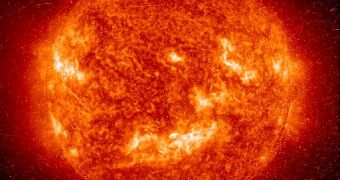One of the most important dangers of outer space missions, invisible and highly lethal, prevents humans from reaching Mars. It's not an alien creature lurking in the darkness of space, but maybe just as bad. Radiation is one of the biggest dangers to long-distance space travelers.
The sudden, unpredictable occurrence of radiation outbursts from the Sun is a real threat that got the attention of space agencies around the world, since such outbursts are really hard to predict.
A team of researchers led by Dr. Arik Posner, a research scientist at Southwest Research Institute (SwRI) is trying to predict when the hazardous particles from extreme solar events, such as flares, coronal mass ejections and radio bursts, would reach humans or technology in space.
Their new method is measuring relativistic, near light-speed electrons in order to anticipate the occurrence and intensity of solar ion events. Since these relativistic electrons are found in large amounts outside of the magnetosphere, they are also easier to detect.
Detecting these electrons is crucial, because they travel ahead of the more dangerous ionized that produce the radiations. Relativistic electrons are produced by extreme solar events whose characteristics can be examined in order to predict the later arriving dangerous particles.
"This method provides advance warning up to about one hour," says Posner. "Although it seems relatively short notice, the warning can be decisive in the prevention of acute radiation sickness and will help astronauts reduce their total exposure to radiation.
Earth's magnetic field helps prevent exposure to solar particle events, but as space exploration leads humans out of this protective magnetic cocoon toward the moon and into the unprotected seas of outer space, this and other methods of space weather forecasting will become increasingly important," says Posner.
Astronauts exposed to these radiations can experience vomiting, skin burns or abruption of central nervous system function, so predicting these phenomena is very important for the success of upcoming missions like Moon and Mars landings.
"A one hour warning would reduce the odds of being caught in a solar storm outside of a lunar habitat, where astronauts are most vulnerable, by more than 20 percent compared to current methods, and allow science missions to venture to farther distances," says Dr. Francis Cucinotta, chief scientist for the NASA Space Radiation Program.

 14 DAY TRIAL //
14 DAY TRIAL //